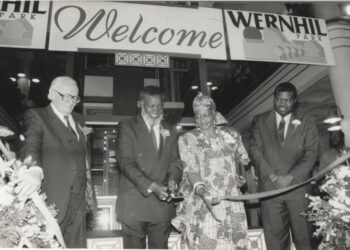
By Helene Vosloo
As Namibia strides forward into an era defined by rapid technological advancement and shifting consumer behaviour, the broadcasting sector remains a cornerstone of information dissemination and cultural expression.
With a population of approximately 3 million, the Namibia’s media landscape encompasses a vibrant mix of public, private, and community broadcasters vying for the attention of an increasingly discerning audience.
However, navigating the complexities of a digital revolution poses both challenges and opportunities for Namibian broadcasting, particularly in terms of sustainability.
A Historical Overview of Broadcasting in Namibia
Historically, the Namibian broadcasting industry was shaped by the South African Broadcasting Corporation’s (SABC) dominance until 1990, when the Namibia Broadcasting Corporation (NBC) was established. The NBC, as the national public broadcaster, is charged with delivering informative, educational, and entertainment content in various indigenous languages, thus addressing the nation’s linguistic and cultural diversity.
Despite being a key player in the broadcasting sector, the NBC operates alongside a growing number of private broadcasters, including Multichoice Namibia, which offers services like DStv and GOtv. The expanding landscape presents an opportunity for diverse content but simultaneously raises questions about market competition and media sustainability.
The Impact of Digitalisation
The rapid proliferation of digital media platforms has fundamentally transformed the broadcasting landscape. For many Namibians, the advent of smartphones and internet access has opened up a world of on-demand content, often free of charge.
While embracing these technological advancements promotes accessibility, it also means traditional broadcasters face obstacles in retaining audiences. Viewership patterns are shifting away from traditional services, and advertising budgets are moving toward digital platforms such as social media and streaming services.
This trend is reflected in a significant decline in advertising revenue for local broadcasters. For instance, between 2021 and 2023, companies like Multichoice and NBC have recorded notable decreases in income, as advertisers favour platforms with larger audiences, often outside Namibia.
A smaller market size further exacerbates this challenge, compelling local broadcasters to operate under resource constraints that limit their ability to produce compelling content, consequently affecting the quality of media produced.
Challenges Facing Namibian Broadcasting
The Namibian broadcasting sector is currently at a pivotal junction, grappling with several pressing challenges:
•   Advertising Revenue Decline: The primary revenue source for broadcasters, advertising, has been severely impacted as businesses reallocate their budgets to digital platforms that offer greater outreach and engagement.
•   Competition from Digital Media: Audiences are increasingly turning to digital platforms for content, which continues to reshape media consumption patterns. These platforms allow for personalisation and convenience that traditional broadcasters struggle to provide.
•   Infrastructure Limitations: Not all areas in Namibia enjoy equal access to broadcast signals, disadvantaging rural audiences who face poor signal quality and limited media options.
•    Content Quality and Creation: High-quality local content production demands significant investment. Budget constraints hinder public broadcasters from creating diverse and engaging offerings that can compete with international productions.
The Role of the Government in Enhancing Broadcasting
To support the Namibian broadcasting sector, the government holds a pivotal role. Efficient policy and investment strategies can lay the groundwork for a robust media environment conducive to growth:
•   Diversification of Revenue Streams: Broadcasters should pivot towards alternative income sources, including subscription services and strategic partnerships with telecommunications providers.
•   Subsidies and Grants: Financial support from the government for public and community broadcasters can alleviate funding challenges, ensuring they continue to produce local content that resonates with audiences.
•   Policy Reforms: Implementing regulatory measures that foster a fair competitive environment and encourage local content production will enhance the broadcasting landscape. Regulations might include quotas for Namibian content which can nurture local industries.
•   Public Awareness Campaigns: Campaigns to promote the significance of local broadcasting can bolster audience engagement and stimulate advertising interest, vital for the sustainability of local media outlets.
•   Investment in Digital Transition: With the transformation from analogue to digital broadcasting, the government can aid broadcasters through grants or technical assistance, facilitating an upgrade to more stable and expansive digital infrastructures.
•   Public-Private Partnerships: Collaborative initiatives between private entities and broadcasters can foster innovation and broaden revenue opportunities, ensuring a diversified content offering.
•    Corporate Social Responsibility Initiatives: Encourage businesses to support local media through CSR initiatives focused on content production. This not only sustains the industry but allows businesses to align themselves with community interests.
•    Enhanced Local Content Production: Investment in local talents and production capabilities enriches the media landscape and cultivates a culturally relevant content pool.
•    Training and Capacity Development: Improving the skills of media professionals ensures better quality production and operational efficiency, vital for fostering a competitive edge.
Conclusion: A Path Forward
Though presenting formidable challenges, the Namibian broadcasting sector’s future is ripe with opportunities for innovation and growth. By blending government support, private collaboration, and embracing digital transformation through diversified strategies, broadcasters can revitalize the industry.
Positioning broadcasting as a vital public service with a democratic role in society, Namibian organizations must continue to serve as platforms for diverse voices and uphold their commitment to responsible information dissemination.
For Namibia, the sustainability of its broadcasting industry is not merely an economic consideration but a cultural imperative — one that strengthens community ties, amplifies local stories, and ultimately enriches the nation’s democratic foundations.
Strategy and foresight are essential as Namibia navigates this transformative era. Ensuring that local broadcasters evolve to remain competitive amidst growing global influences will require a cooperative approach.
With sustained efforts, the Namibian government and industry stakeholders can forge a pathway that secures a vibrant and equitable media environment for future generations.
*Helene Vosloo is Executive: Economics & Market Development at the Communications Regulatory Authority of Namibia (CRAN)











